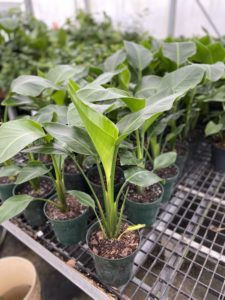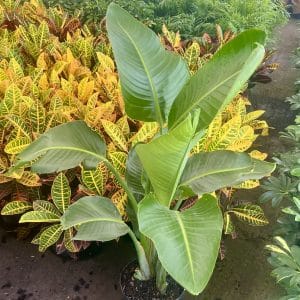
An indoor Bird of Paradise is a slow growing plant with large paddle- shaped leaves that resemble those of a banana plant. Even indoors, a Bird of Paradise plant can easily reach a height of 6ft-7ft. This plant produces multiple large, leathery leaves sometimes 3ft or more in length. After 4 or 5 years, an indoor Bird of Paradise (Strelitzia Reginae) may, on rare occasions, produce an exotic orange/red flower that resembles the head of a crane.
A Bird of Paradise plant requires very bright light. This plant can even be placed in the direct sun if you do it gradually and allow the leaves to slowly adapt. You may have to move a Bird of Paradise plant to different areas of your home as the seasons change in order to give it adequate light; placing it close to a south- facing window is always best.
In the spring and summer keep the soil moist but never soggy. A Bird of Paradise plant needs less water in the fall and winter. Water from the bottom so the soil stays loose and remains well aerated. Water that has a high salt content burns the leaves.
An indoor Bird of Paradise plant grows best in temperatures between 65°-75°F (18.3°-23.9°C) during the spring, summer, and fall. In the winter, when the plant is “resting,” keep the temperature 10° cooler. Temperatures below 50°F (10.0°C) cause the leaves to curl and turn black.
A Bird of Paradise plant does well in basic household humidity.
Unlike the outdoor varieties, an indoor Bird of Paradise plant rarely blooms.
A Bird of Paradise is susceptible to scale, Mealy Bugs, and spider mites. Fortunately, these Plant Pests are quickly detected on the large broad leaves and easily wiped off with a soft cloth or warm soapy water. Alcohol, leaf shine, or any spray pesticide should never be used on the leaves; they harm the matte finish on the leaves.
The large leaves of a Bird of Paradise Plant are susceptible to a plant disease called Leaf Spot which can be caused by either a fungus or a bacteria. Remove infected leaves from the Bird of Paradise Plant quickly, clean out any leaf pieces in the soil, and avoid getting water on the leaves. If using a commercial Fungicide, test it first on a small section of a leaf to be sure it won’t ruin its appearance.
Cut off any dead or damaged leaves and stems close to the soil.
A Bird of Paradise rests in the fall and winter and requires less water, and cooler temperatures.

